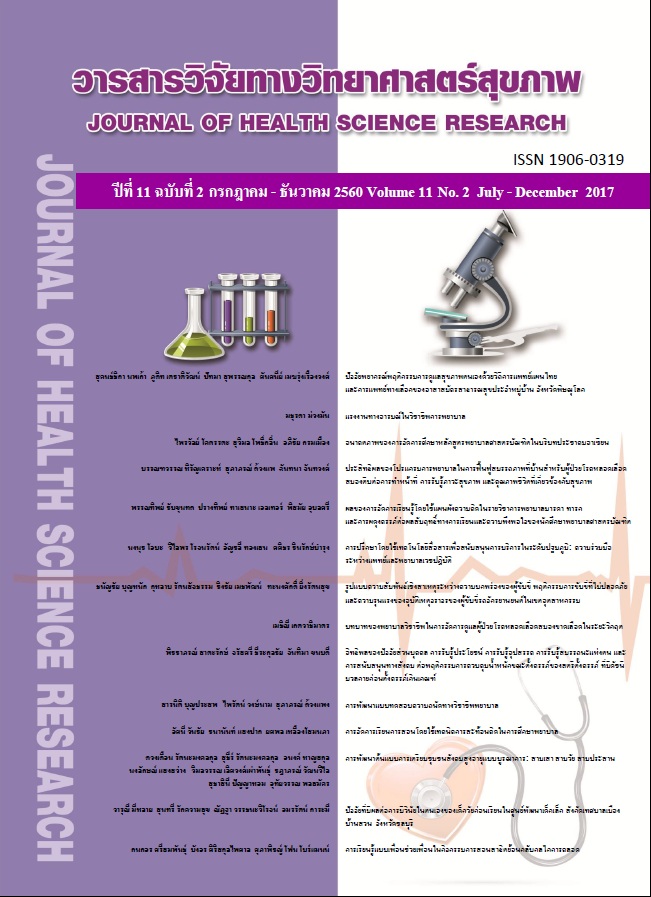ประสิทธิผลของโปรแกรมการพยาบาลในการฟื้นฟูสมรรถภาพที่บ้านสำหรับผู้ป่วยโรคหลอดเลือดสมองตีบต่อการทำหน้าที่ การรับรู้ภาวะสุขภาพ และคุณภาพชีวิตที่เกี่ยวข้องกับสุขภาพ
Main Article Content
บทคัดย่อ
บทคัดย่อ
การฟื้นฟูสมรรถภาพผู้ป่วยโรคหลอดเลือดสมอง คือการส่งเสริมการทำหน้าที่และพัฒนาคุณภาพชีวิตของผู้ป่วยให้ดีขึ้น จากการทบทวนวรรณกรรมพบว่า โปรแกรมการฟื้นฟูสมรรถภาพผู้ป่วยโรคหลอดเลือดสมองที่บ้านพบว่ามีจำนวนน้อย การวิจัยกึ่งทดลองแบบสองกลุ่มเปรียบเทียบครั้งนี้ กลุ่มตัวอย่าง คือ ผู้ป่วยโรคหลอดเลือดสมองตีบที่จำหน่ายกลับบ้านจากโรงพยาบาลพหลพลพยุหเสนา และอาศัยอยู่ในจังหวัดกาญจนบุรี โดยการสุ่มตัวอย่างแบบง่าย จำนวน 48 ราย ซึ่งได้รับคัดเลือกเข้ากลุ่มทดลองและกลุ่มควบคุม กลุ่มละ 24 ราย กลุ่มทดลองได้รับกิจกรรมการดูแลตามโปรแกรมฯ จำนวน 12 สัปดาห์ แบ่งเป็น 3 ระยะ คือ ระยะที่ 1 ประเมินความต้องการของผู้ป่วยแต่ละรายอย่างครอบคลุมและการวางแผนการฟื้นฟูฯ ระยะที่ 2 การฟื้นฟูสมรรถภาพที่บ้านรายบุคคล ระยะที่ 3 การติดตามดูแลต่อเนื่อง ส่วนกลุ่มควบคุมได้รับการดูแลตามปกติจากบุคลากรทางสุขภาพ เครื่องมือที่ใช้ คือ แบบประเมินกิจวัตรประจำวัน แบบสอบถามการรับรู้ภาวะสุขภาพ และแบบสอบถามคุณภาพชีวิต ผู้วิจัยเก็บรวบรวมข้อมูลจำนวน 4 ครั้ง คือ ก่อนการทดลอง ขณะทดลองในสัปดาห์ที่ 4 และ 8 และหลังการทดลองในสัปดาห์ที่ 12 วิเคราะห์ข้อมูลโดยใช้สถิติเชิงพรรณนาและการวัดความแปรปรวนซ้ำพหุคูณ
หลังการทดลอง 12 สัปดาห์ พบว่า กลุ่มทดลองมีผลลัพธ์ทางสุขภาพโดยรวม (การทำหน้าที่ การรับรู้ภาวะสุขภาพ และคุณภาพชีวิตที่เกี่ยวข้องกับสุขภาพ) สูงกว่ากลุ่มควบคุมอย่างมีนัยสำคัญทางสถิติ (V = .56, F (3.44) = 18.84, p < .001) และพบว่ากลุ่มทดลองมีผลลัพธ์ทางสุขภาพโดยรวมดีกว่ากลุ่มควบคุม เมื่อวัดซ้ำในสัปดาห์ที่ 4, 8 และ 12 (V = .96, F (9.38) = 1.08, p < .001) นอกจากนี้เมื่อทดสอบการมีปฏิสัมพันธ์ระหว่างกลุ่มและเวลาพบว่า กลุ่มทดลองมีผลลัพธ์ทางสุขภาพโดยรวมสูงกว่ากลุ่มควบคุม (V = .83, F (9, 38) = 20.54, p < .001) ผลที่ได้จากการศึกษาครั้งนี้แสดงให้เห็นถึงประโยชน์ของโปรแกรมการพยาบาล ในการฟื้นฟูสมรรถภาพที่บ้านหลังจากจำหน่ายออกจากโรงพยาบาล ซึ่งพยาบาลและบุคลากรด้านสุขภาพสามารถนำไปเป็นแนวทางในการส่งเสริมการดูแลที่บ้านสำหรับผู้ป่วยโรคหลอดเลือดสมองตีบอย่างมีประสิทธิภาพได้
Abstract
Rehabilitation of stroke patients is necessary to enhance their performance and quality of life. Review of the literature found rehabilitation programs for stroke patients at home are limited. For this study a quasi - experimental research design was applied. Participants were ischemic stroke patients discharged from Paholpolpayuhasena Hospital and living in Kanchanaburi province. Forty eight participants were randomly assigned to an intervention group (n = 24) and a control group (n = 24). Participants of the intervention were investigated during 12 weeks in three phases: 1) comprehensive individual need assessment and planning for rehabilitation, 2) individualized home-based rehabilitation, and 3) follow-up continuing care. Patients of the control group received routine care only from health professionals. The assessment-instruments were the Barthel Index, the Thai General Health Questionnaire, and the SF-36. Data were collected four times, at baseline, during intervention at week 4 and 8, and after finishing the intervention at week 12. Data were analyzed by using descriptive statistics and repeated measure MANOVA.
The overall health outcome scores of the intervention group (functional status, health perceptions, and Health Related Quality of Life) were significantly higher than those of the control group (V = .56, F (3.44) = 18.84, p < .001). Multivariate analysis also showed a significant time related effect (V = .96, F (9.38) = 1.08, p < .001). During the investigation period health outcome of the intervention compared to the control group improved (V = .83, F (9, 38) = 20.54, p < .001). Our results indicate the benefits of HRNP intervention for ischemic stroke survivors after discharge. It is therefore recommended that nurses and other health care personnel apply this home based program.
Downloads
Article Details
บทความที่ได้รับการตีพิมพ์เป็นลิขสิทธิ์ของวิทยาลัยพยาบาลบรมราชชนนี จังหวัดนนทบุรี
ข้อความที่ปรากฏในบทความแต่ละเรื่องในวารสารวิชาการเล่มนี้เป็นความคิดเห็นส่วนตัวของผู้เขียนแต่ละท่านไม่เกี่ยวข้องกับวิทยาลัยพยาบาลบรมราชชนนี จังหวัดนนทบุรี และคณาจารย์ท่านอื่น ในวิทยาลัยฯ แต่อย่างใด ความรับผิดชอบองค์ประกอบทั้งหมดของบทความแต่ละเรื่องเป็นของผู้เขียนแต่ละท่าน หากมีความผิดพลาดใด ๆ ผู้เขียนแต่ละท่านจะรับผิดชอบบทความของตนเองแต่ผู้เดียว


